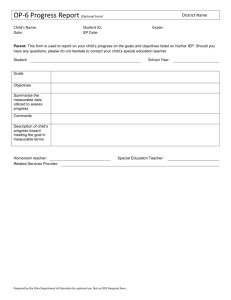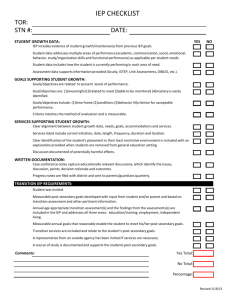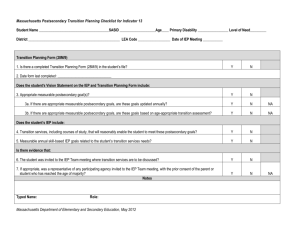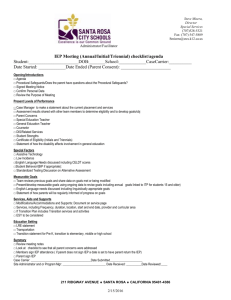PPT - Texas Transition Conference
advertisement
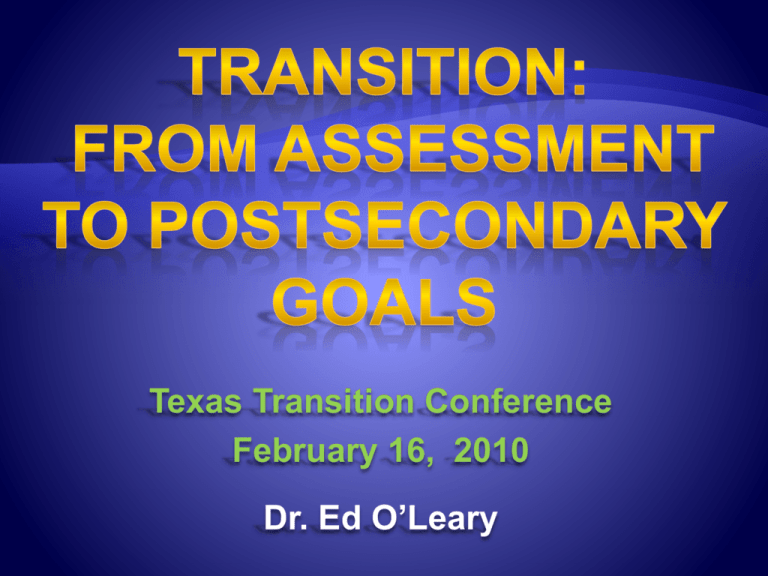
Texas Transition Conference February 16, 2010 Dr. Ed O’Leary Purpose: A free appropriate public education... designed to meet their unique needs and prepare students for further education, employment and independent living. Shift in emphasis to: Results oriented approach. Focus on improved results. Many states fail to ensure compliance with the law's secondary transition services provisions. Why? People do not know “what to do” People do not know “how to do it” Indicator 13 Transition Services in Schools Indicator 14 Employment and Postsecondary Outcomes O’Leary, E. 2008 Annual report to the public on the performance of each local educational agency according to the targets in the SPP. Annual report to the Secretary on its performance according to the states SPP targets. This report is called the Part B Annual Performance Report (APR). Outlines 20 Indicators that must be reported annually Provides Data Sources and Measurement Delineates Measurable and Rigorous Targets for the Six Years of the Plan Outlines Improvement Activities Four indicators deal directly with transition efforts Percent of youth aged 16 and above with an IEP that includes appropriate measurable postsecondary goals that are annually updated and based upon age appropriate transition assessment; and IEP that includes transition services, including courses of study, that will reasonably enable the student to meet those postsecondary goals; an IEP that includes annual goals related to the student’s transition services; evidence that the student was invited to the IEP Team meeting where transition services will be discussed; and evidence that a representative of any participating agency was invited to the IEP Team meeting with the prior consent of the parent or student who has reached the age of majority. March 2009 TOPs and Indicator 13 Questions • Evidence that the student was invited to their IEP meeting. • Not required to report in the FFY 2008 APR (February 2010). Can if want to. • New “Baseline” and improvement activities in FFY 2009 APR (February 2011) • 2009/20010 – should gather data for new baseline for FFY 2009 APR - (February 2011) • First “Reporting” - FFY 2010 (2011/2012 School year) February 2012 APR 1. The IEP includes measurable postsecondary goals. 2. Initial transition services discussion occurs no later than the first IEP to be in effect when the student turns 16 3. Age appropriate transition assessments are completed 4. Student strengths and needs are identified 5. The IEP is reviewed and updated at least annually 6. Annual IEP goals facilitate movement toward postsecondary goals 7. The student is invited to ARD/IEP meeting. 8. Student preferences and interests are taken into consideration in the development of the IEP . 9. Student needs, taking into account student strengths, preferences and interests are reflected in identified postsecondary goals. 10. Based on student needs, transition services in the form of coordinated activities include instruction, related services, community experiences, development of employment/adult living and if appropriate, acquisition of daily living skills and provision of functional vocational evaluation 11. The IEP includes a course of study that supports postsecondary goals. 12. With the consent of parents or adult student, any agency responsible for providing transition services is invited to the ARD/IEP meeting. 13. The ARD committee reconvenes to develop alternative strategies when participating agencies failed to provide transition services. Broad definition: Formal process of cooperative planning that will assist students with disabilities to move from school into the adult world. Present Level of Performance O’Leary, E., 1998 © Copyright Annual Goals Short Term Objectives Step II: Present Levels of Academic Achievement and Functional Performance Step I Measurable Post-secondary Goals Step III: Transition Services Step IV: Measurable Annual Goals Includes: Courses of study Ageappropriate transition assessments •Training •Education •Employment •Independent Living Skills – where appropriate Includes: •Instruction •Related services •Community experiences •Employment and other postschool adult living objectives When appropriate: •Daily living skills •Functional vocational evaluation O’Leary, E., 2005 © Copyright Is there evidence that the student was invited to the ARD/IEP team meeting? Every student who’s IEP will be in effect when the student turns 16 years of age, or younger if determined appropriate by the IEP team, must be invited to their IEP meeting. Documented evidence in the IEP or cumulative folder that the student was invited to attend the IEP team meeting. One of the most critical practices to immediately improve the development and delivery of transition services that will impact post school results is to actively engage the student in all discussions and decision making in their IEP Who Talked The Most – The Least Average Length of Meeting Teacher Directed 29.05 minutes Student Self-Directed 33.57 minutes Student directed meetings are not statistically significantly longer than teacher-directed meetings. Beginning with the first IEP to be in effect when the student turns 16 years of age, or younger if determined appropriate, the student must be invited to their IEP meeting. Parent Notice is NOT an invitation to the student to attend their IEP meeting. Invitation to attend does not mean equal opportunity for participation or decision making. Step II: Present Levels of Academic Achievement and Functional Performance Step I Measurable Post-secondary Goals Step III: Transition Services Step IV: Measurable Annual Goals Includes: Courses of study Ageappropriate transition assessments •Training •Education •Employment •Independent Living Skills – where appropriate Includes: •Instruction •Related services •Community experiences •Employment and other postschool adult living objectives When appropriate: •Daily living skills •Functional vocational evaluation O’Leary, E., 2005 © Copyright Step I Measurable Post-secondary Goals •Training /Education •Employment •Independent Living Skills – (where appropriate) O’Leary, E., 2005 © Copyright Age-appropriate transition assessments Measurable Annual Goals Educators/Systems Measurable Post secondary Goals Student’s Is there evidence that the measurable postsecondary goals were based on age-appropriate transition assessment? Division of Career Development & Transition Transition assessment is "the ongoing process of collecting data on the individual’s strengths, needs, preferences, and interests as they relate to the demands of current and future working, educational, living, and personal, and social environments. Assessment data serve as the common thread in the transition process and form the basis for defining goals and services to be included in the IEP" (Sitlington, 1996). Measurable Postsecondary Goals – Help students define their MPG’s Course of study – Help students determine and plan courses and educational experiences Transition services – coordinated set of activities – what needs to happen by when, and who will be responsible to carry out and oversee each activity Promotes self advocacy and self-awareness 1. Explain the purpose of assessments to students (MPG’s, course selection, develop long range plan and activities). 2. Describe the variety of assessments (career, self determination, life skills, etc.) assessment tools and the different kinds of results. 3. With the student, decide which assessments/assessment tools. 4. Conduct assessments. 5. With the student review results: What the results mean Why the results How the information can be used 6. Have students report on assessments – what – why - the results and how they used the information to define their MPG’s. ‘Career Cruising’ TPI Enderle Severson Transition Rating Scale Instrument for Client and Agency Planning – ICAP Texas Labor Market and Career Information Our mission is to improve the way Texans make career and educational decisions by providing useful and reliable information about careers, educational training options and jobs. Products are designed to support informed educational and career decisions World of Work Reality Check World of Work On-line Self Assessment • O*NET Work Importance Locator – find occupations based upon work values. • Interest Profiler self-assessment – find occupations based upon what one would like or dislike doing. • Job description • Training • Knowledge, skills, abilities • Tasks • Work Values • Labor Market trend for TX World of Work http://www.texascaresonline.com/wowmenu.asp On-line Reality Check After high school you will need to pay for housing, transportation, clothes, entertainment… Find out how much you will need and which career will pay for all of your needs Reality Check http://www.lmci.state.tx.us/realitycheck/ Career-related elementary level activities workbook http://www.cdr.state.tx.us/shared/CareersAreEverywhere.asp NSTTAC – NSTTAC.ORG Products and Resources Transition Assessment Guide What is transition assessment? Why conduct transition assessments? How do I select instruments? How do I conduct an age appropriate transition assessment? Sample Instruments Informal Assessment Formal Assessment Informative links to Podcasts and other sources of information about age appropriate transition assessment Self-Determination Assessments American Institute for Research Self –Determination Assessment ARC Self-Determination Scale ChoiceMaker Self-Determination Assessment Field and Hoffman Self-Determination Assessment Battery http://education.ou.edu/zarrow Adaptive Behavior and Transition Assessments Transition Planning Inventory (TPI) ProEd, Austin TX www.proedinc.com Scales of Independent Behavior Riverside Publishing www.riverpub.com Informal Assessments for Transition Planning ProEd, Austin TX www.proedinc.com Enderle-Severson Transition Rating Scale www.estr.net Casey Life Skills www.caseylifeskills.org On-Line Individual Interest Inventories My Future www.myfuture.com/toolbox/workinterest.html I Oscar (Occupation and Skill Computer-Assisted Researcher) www.ioscar.org Career Voyages http://www.careervoyages.gov/ Career Clusters www.careerclusters.org Occupational Outlook Handbook www.bls.gov/oco/home.htm www.bls.gov/k12/index.htm (Exploring Careers) Job Videos http://www.acinet.org/acinet/videos.asp?id=27,&nodeid=27 Students with Moderate to Severe Disabilities Choose and Take Action – www.sopriswest.com Set of instructional activities designed to teach students with moderate to severe cognitive disabilities selfdetermination skills to introduce students to a variety of jobs and career possibilities and help them to identify what is most important to them about a job. Step I Measurable Post-secondary Goals •Training /Education •Employment •Independent Living Skills – (where appropriate) O’Leary, E., 2005 © Copyright Age-appropriate transition assessments Is there an appropriate measurable postsecondary goal or goals that covers • education or training • employment, and • as needed, independent living? The IEP contains a measurable postsecondary goal or goals for the student in education/training, employment and where appropriate, independent living skills. Statement based on age appropriate transition assessments. Articulates what the student would like to achieve after high school. Measurable means it is countable and is an outcome, not a process. If the goal is measurable and occurs after the student has left…I am concerned about liability issues when student’s don’t meet the stated goals after school. NSTTAC Response …IDEA 2004 does not require that LEAs are held accountable for the attainment of postsecondary goals. The stated measurable postsecondary goals are required components of transition planning. There are numerous mediating factors that positively or negatively affect an adult's acquisition of goals, for which a school could not be held accountable. The purpose of the legislation and this indicator is that a student's education program support their goals beyond secondary school. NSTTAC Indicator 13 Checklist Frequently Asked Questions and Responses – Question # 14 www.nsttac.org/pdf/i13checklistqa.pdf A statement based on age appropriate transition assessment Communicates what the student would like to achieve after high school. Is measurable An outcome that occurs after the person has exited high school. A measurable postsecondary goal is NOT an activity, step, wishful intent or the process of pursuing or moving toward the desired outcome. Any student who will turn 16 (14) during the timeframe of their IEP, or younger, if determined appropriate by the IEP team as required under IDEA 2004 Can the Goal be Counted/Measured? Measurable postsecondary goals are Outcomes that occur after the person has left high school. What a student WILL do (attend, work, etc.) I will attend the U of W in the teacher education program. Can count or measure whether the student does or does not “attend” A measurable postsecondary goal is not a Process. It is not what a student “plans” or “hopes to” do. I am planning on attending the U of W in the teacher education program. Cannot measure or count “planning on attending” NSTTAC 12-06 Use results-oriented terms such as “attend”, “work”, “live independently” Use descriptors such as “full time” and “part time” Begin with “After high school…” Training or Education Specific vocational or career field, independent living skills training, vocational training program, apprenticeship, OJT, job corps, 4 year college or university, technical college, 2 year college, Vocational Technical School (less than a two year program) etc. Employment Paid (competitive, supported, sheltered); unpaid employment (volunteer, in a training capacity); military; etc. Independent Living, where appropriate Adult living, daily living, independent living, financial, transportation, etc. Initially, broad descriptions of the student’s preferences, interests, or vision of what they might like to do in employment, education, training, and independent living . Each year reassess and refine. Should be specific and measurable one year out by last year/IEP. 1. Training/Education After high school, I/David will get on the job training to become a farmer. 2. Employment After high school, I/David will work full time as a farmer. Independent Living (where appropriate) After high school, I/Mary will live with a roommate in an apartment. Training/Education After high school, Eric will get on the job training in an area related to dirt bike racing. Employment After high school, Eric will work full time with dirt bikes. Independent Living After high school, Eric will live in an apartment with friends. Training/Education After high school, Sheila will enroll full time at UW-Eau Claire in the nursing program. Employment After high school, Sheila will work full time as a nurse. 1.Independent Living • • After completion of school, I/ Lance will live with my mother and continue to take part in community activities like bowling, going to church and visiting friends and family. With mom 2. Training/Education • After completion of school, I /Lance will attend the XYZ Center and receive training on work behaviors and skills. • Lance did not respond 3. Employment • • After completion of school, I/ Lance will be employed in a sheltered environment at the XYZ Center. With mom 1.Independent Living • • After completion of school, I /William will live with my brother and take part in community social and recreational activities. With my brother 2. Training/Education • After completion of school, I /William will attend ADAPT and receive vocational skills training. • “blank” 3. Employment • • After completion of school, I will work at ADAPT under their supported employment program. Wants to work – cardboard boxes, pop machines, cleaning 1.Independent Living • • After completion of school, I /Wayne will live at home. Seems to like living at his house. He smiles when asked about it 2. Training/Education • After completion of school, I/ Wayne will attend ADAPT and receive vocational skills training. • Likes attending DKDC and would like to for a while. 3. Employment • • After completion of school, I will work at ADAPT under their supported employment program. Wayne does not want to talk about getting a job. Bill has significant limitations across all areas of functioning as well as being medically fragile. Training programs will not be appropriate for him. He will require full time nursing care throughout his life and recreational day service programs designed for individuals with such specific needs will probably be most appropriate following high school. 18 years old. Receives specially designed instruction with an alternate curriculum in a self-contained setting all day. Receives related services of OT, PT and nursing Fed via G-tube Has tracheotomy and uses a ventilator with oxygen to breathe Strengths Curious, stays alert and awake throughout the school day, seems to enjoy activity around him. Enjoys getting verbal and tactile attention from his peers and staff. Tolerant of position changes on mat table and allows hand-over-hand assistance to participate in activities. Likes using a switch (with assistance) to activate a variety of devices, including the radio and computer. Present Levels of Academic Achievement and Functional Abilities Benefits from sensory stimulating activities and activities to improve his independence and communication. Uses facial gestures to communicate his pleasure and displeasure with his current state. Offers a smile to show happiness and a blank stare to show his disinterest. Picture/symbol augmentative communication supports have not been successful. Will use simple one-button communication devices with assistance when offered during class activities. Uses a manual wheelchair dependently. Requires a 2-person lift or mechanical device for all transfers. Tolerates positioning on mat table. Limited fine motor skills result in dependency for all care and hand-over-hand assistance for all activities. Education/Training Training programs are not appropriate After graduation, Bill will participate in an in-home or center-based program designed to provide habilitative and vocational training with medical and therapeutic supports. After graduation, Bill will participate in on the job training in using micro switches Employment Recreational day service program. Following graduation Bill will participate in technologically supported self-employment or volunteer work and receive job development services from vocational rehabilitation or a community rehabilitation program within 1 year of graduation. Independent Living After graduation Bill will live at home and participate, to the maximum extent possible, in his daily routines (e.g. feeding, dressing, bathing, activating small appliances/media devices, choice making, etc.) and environment through the use of technology. After graduation Bill will participate in communityintegrated recreational/leisure activities at the YMCA, going to movies, going to church. After graduation Bill will utilize an augmentative communication device at home and in the community that allows individuals to communicate with him regarding needs, wants, and desires. Employment After completion of school Bill will volunteer at the Heritage nursing home. Step II: Present Levels of Academic Achievement and Functional Performance Step I Measurable Post-secondary Goals Step III: Transition Step IV: Measurable Services Annual Goals Includes: Courses of study Ageappropriate transition assessments •Training •Education •Employment •Independent Living Skills – where appropriate Includes: •Instruction •Related services •Community experiences •Employment and other postschool adult living objectives When appropriate: •Daily living skills •Functional vocational evaluation O’Leary, E., 2005 © Copyright Step III: Transition Services 1.Courses of study Includes 2.Coordinated set of Activities - Instruction - Employment and other post-school adult living objectives - Related services - Community experiences - Employment and other post-school adult living objectives When appropriate: - Daily living skills - Functional vocational evaluation O’Leary, E., 2005 © Copyright Step III: Transition Services 1.Courses of study Includes 2.Coordinated set of Activities - Instruction - Employment and other post-school adult living objectives - Related services - Community experiences - Employment and other post-school adult living objectives When appropriate: - Daily living skills - Functional vocational evaluation O’Leary, E., 2005 © Copyright Do the transition services include courses of study that will reasonably enable the student to meet his or her postsecondary goal(s)? Locate the course of study (instructional program of study) or list of courses of study in the student’s IEP. The courses of study a multi-year description of coursework from the student’s current to anticipated exit year that is designed to help the student achieve their desired post-school goal(s). The ARD/IEP team helps the student identify the courses and educational experiences that will prepare them for post-secondary life. Focus on: — — — Courses of study [all courses and educational experiences] How the educational program can be planned and relate directly to the student’s goals beyond secondary education Show how those courses are linked to the MPG’s Promotes the concept that the high school program focuses on post-school results. Help students and family select courses of study that are meaningful and motivate students to complete their education. If the student and parent are aware of and agree to a change in a course and that change would not have a direct impact on the student achieving his or her desired post-school outcome; or if the student taking the course would not require any accommodations or modifications (which would require goals and objectives); then this change would not be considered a substantive change and would not necessitate another IEP meeting. Step III: Transition Services 1.Courses of study Includes 2.Coordinated set of Activities - Instruction - Employment and other post-school adult living objectives - Related services - Community experiences - Employment and other post-school adult living objectives When appropriate: - Daily living skills - Functional vocational evaluation O’Leary, E., 2005 © Copyright Are there transition services in the IEP that will reasonably enable the student to meet his or her postsecondary goal(s)? For each measurable postsecondary goal area there should be some type of instruction, related service, community experience, employment and other post-school adult living objective, daily living skill and/or functional vocational evaluation listed in association with meeting the measurable postsecondary goal. The transition services and activities (actions/steps) described under all of these areas is a coordinated plan for the transition from school to post-school adult life. “Herding Cats” The CSA must show evidence that: 1. Activities are individualized and student specific. 2. Activities lead toward the achievement of the student’s measurable postsecondary goals 3. Activities should show a minimum of 2 years 4. The activities demonstrate coordination between school, family, student and/or outside agency(ies) Multi year - at least a 2 year description of coordinated activities/strategies to help students achieve their measurable post secondary goals while they are still in high school Should complement the course of study, include steps/activities needed for successful post school transition If there are transition services listed that are likely to be provided or paid for by an outside agency then you need to obtain written consent before inviting agency representative to the IEP meeting. Step II: Present Levels of Academic Achievement and Functional Performance Step I Measurable Post-secondary Goals Step III: Transition Services Step IV: Measurable Annual Goals Includes: Courses of study Ageappropriate transition assessments •Training •Education •Employment •Independent Living Skills – where appropriate Includes: •Instruction •Related services •Community experiences •Employment and other postschool adult living objectives When appropriate: •Daily living skills •Functional vocational evaluation O’Leary, E., 2005 © Copyright Is (are) there annual IEP goal(s) related to the student’s transition services needs? Find the annual goals, or, for students working toward alternative achievement standards, or States in which short-term objectives are included in the IEP, short-term objectives on the IEP. Find the transition services associated with the measurable postsecondary goal. For each of the measurable postsecondary goals areas there should be an annual goal (or short-term objective) included in the IEP related to the student’s transition services needs. Education Strategy/activity Transition Services Strategy/activity All activities and services 1. 2. 3. 4. 5. 6. 7. 8. 9. 10. 11. 12. Strategy/activity Strategy/activity Strategy/activity Strategy/activity Strategy/activity Strategy/activity Strategy/activity Strategy/activity Strategy/activity Strategy/activity Strategy/activity Strategy/activity General Education Strategies activities for current year 1. 2. 3. 4. 5. 6. Activity Activity Activity Activity Activity Activity Rehab Strategy/activity Student Strategy/activity Strategy/activity Parent Strategy/activity Others Strategy/activity O’Leary, E., 2005 © Copyright Special Education Annual Goals
